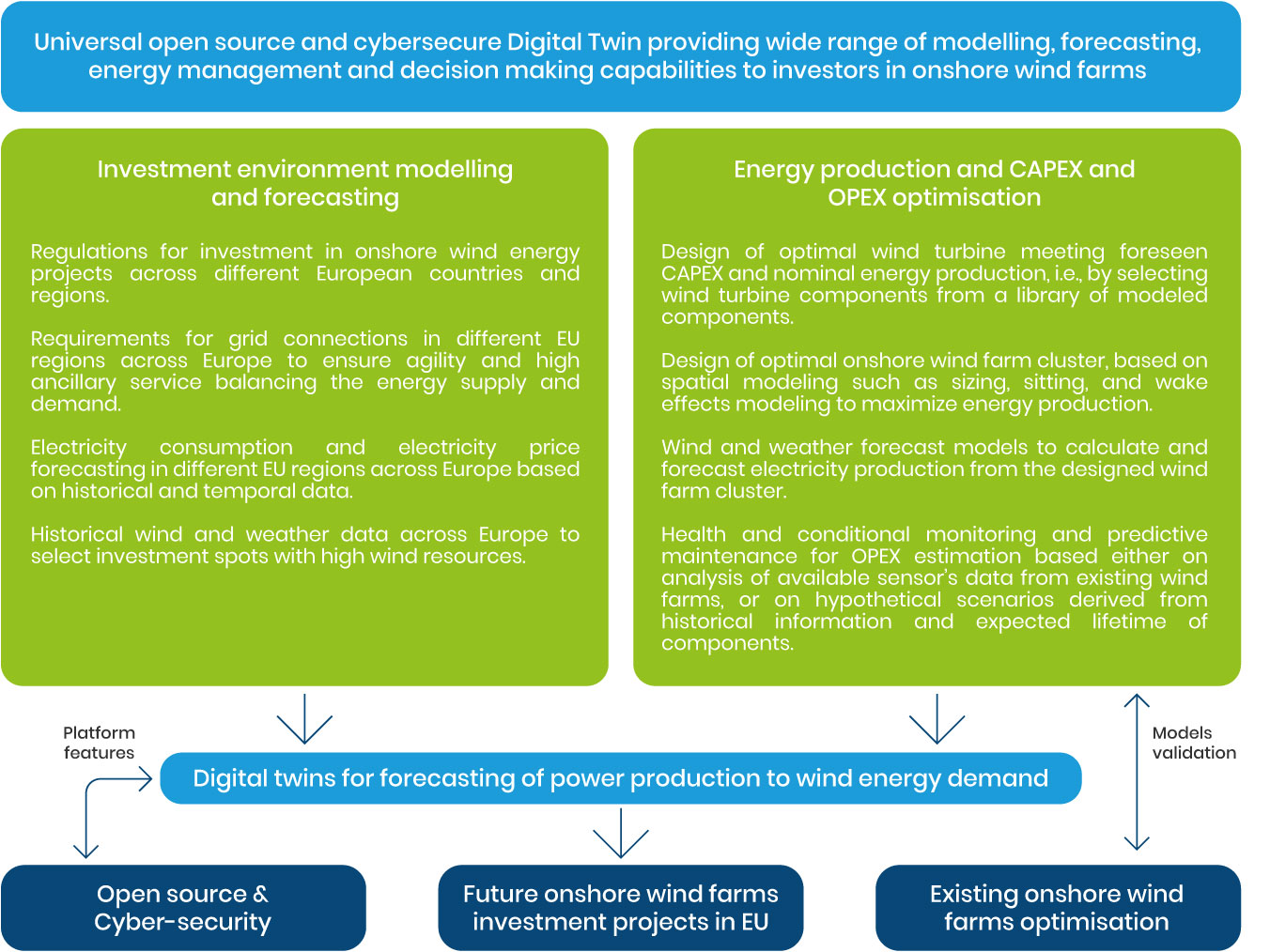The aim of TWINVEST is to develop the foundations of a universal open source and cybersecure Digital Twin (TRL2) that will represent the main trustable and collaborative environment for different stakeholders in the onshore wind energy sector, including wind farm owners, operators, investors, technology developers, and policymakers.
This innovative tool will provide users with insights that help optimise operations, reduce risks, and make informed decisions about wind farm design, investment opportunities, operational efficiency, and long-term sustainability in the onshore wind energy sector.
The project aims to establish a new digital tool that operates as a cloud service, utilising a web-based interface to deliver all services and functionality. Thus, TWINVEST will also design and implement protocols for cyber security to safeguard critical systems and data from malicious attacks, protect privacy, and maintain the integrity and reliability of digital infrastructure and operations.
TWINVEST will consider two major environments in the project:
- To model and forecast the investment environment for future investment decisions in a particular region in Europe
- To model, forecast and optimise the energy production or drawback on the performance of the system and the overall investment.
HIGH-LEVEL TWINVEST CONCEPT
PLATFORMS AND OBJECTIVES
The architecture of the Digital Twin will be structured around four distinct platforms, each addressing a specific category of challenges essential for collectively modeling the complex onshore wind energy system. This modular approach ensures that diverse categories of stakeholders can focus on solving specialised problems without disrupting the integrity or functionality of the overall simulation environment.
1. Develop a Framework Investment conditions Platform
This platform will model and forecast the framework conditions and requirements in different regions in Europe, in order to facilitate the decision for investment in future onshore wind farms in promising places and markets in Europe. This platform will aim at:
- Identifying regulations across different countries and regions in Europe specifying the conditions for investments in future wind farms and requirements from connections to the grid.
- Provide electricity market price information in different geographical areas in Europe, as well as forecasted electricity demand based on historical data and future market, economic and demographic trends.
- Provide a library of battery-based electricity storage technologies and their forecasted CAPEX and OPEX.
- Assess the grid connection and management requirements for ancillary services, taking into consideration the voltage and reactive power control together with the energy production and the storage assets.
2. Develop the Components to Farm Platform
This innovative framework will serve as the foundation for modelling a wind farm nominal energy production and providing predicted CAPEX from design to operation.
3. Develop the Environment and Earth Platform
This platform will use hybrid Artificial Intelligent (AI) algorithms able to accurately forecast the energy production of wind farms considering weather and spatial modelling to improve the siting and sizing of the farm at any European location.
- Create of a novel hybrid AI-based forecasting models for various time periods to forecast wind and weather data and to accurately forecast the energy production of wind turbines
- Integrate in the Environmental and Earth Platform, and optimisation
4. Develop the Maintenance and risk Platform
- This platform will analyse data from the SCADA system (containing large datasets from sensors and energy production) using AI powered multi-concern diagnostics tool for performing due diligence in order to optimise the energy production efficiency while providing guidance on predictive maintenance and risk assessment to minimise downtime and OPEX and therefore reduce the Levelised cost of energy (LCOE).
- Detect early mechanical failures through Acoustic Emission (AE) focusing on rotating parts of the turbine, such as the gearbox, drive train, generator bearing and yaw system.
- Develop a multi-domain tool based on novel hybrid AI algorithms, experimental data, and multiphysical theoretical models that is able to perform predictive and preventive maintenance for onshore wind within the DT.
- Examine the influence of extreme events such as high wind, ice, lightning, and seismic activities on wind farms to overcome potential challenges in design, development, operations, finance, and environmental aspects.
- Develop an Energy Management System (EMS) as a decision tool to collaborate with the aforementioned tools and provide recommendations for optimising the efficiency of the wind farm while reducing the down time and extending the lifetime of the components and ultimately lowering the LCOE.
5. Validation and optimisation of the digital twin’s output on physical and virtual use cases to effectively assess the capability of the DT to provide useful information and facilitate investment decisions.
6. Digital twin exploitation roadmap beyond the project lifetime, and effective communicating, and disseminating towards industrial and scientific communities, and public at large.
The above platforms and models will be integrated to provide the expected open source and user-friendly Digital Twin.
